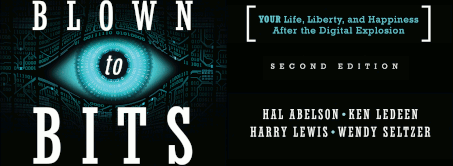The FCC Rules Against Comcast
Wednesday, August 20th, 2008 by Harry LewisThe Federal Communications Commission has issued its decision in the matter of Comcast’s violations of network neutrality, finding Comcast to have violated federal policy. The full opinion (and the opinions of individual commissioners) is posted on the FCC site (Microsoft Word document here). We cut and paste a few paragraphs below (omitting footnotes). Comcast’s response will apparently be just to slow down all traffic to its heaviest users during times of peak traffic — rather than peeking inside the packets to decide whom to delay or block.
The record leaves no doubt that Comcast’s network management practices discriminate among applications and protocols rather than treating all equally. To reiterate: Comcast has deployed equipment across its networks that monitors its customers’ TCP connections using deep packet inspection to determine how many connections are peer-to-peer uploads. When Comcast judges that there are too many peer-to-peer uploads in a given area, Comcast’s equipment terminates some of those connections by sending RST packets. In other words, Comcast determines how it will route some connections based not on their destinations but on their contents; in laymen’s terms, Comcast opens its customers’ mail because it wants to deliver mail not based on the address or type of stamp on the envelope but on the type of letter contained therein. Furthermore, Comcast’s interruption of customers’ uploads by definition interferes with Internet users’ downloads since “any end-point that is uploading has a corresponding end-point that is downloading.” Also, because Comcast’s method, sending RST packets to both sides of a TCP connection, is the same method computers connected via TCP use to communicate with each other, a customer has no way of knowing when Comcast (rather than its peer) terminates a connection.
but invasive and outright discriminatory. Comcast admits that it interferes with about ten percent of uploading peer-to-peer TCP connections, and independent evidence shows that Comcast’s interference may be even more prevalent. In a test of over a thousand networks over the course of more than a million machine-hours, Vuze found that the peer-to-peer TCP connections of Comcast customers were interrupted more consistently and more persistently than those of any other provider’s customers. Similarly, independent evidence suggests that Comcast may have interfered with forty if not seventy-five percent of all such connections in certain communities. Comcast also admits that even in its own tests, twenty percent of such terminated connections cannot successfully restart an uploading peer-to-peer connection within a minute. These statistics have real world consequences: We know, for example, that Comcast’s conduct disconnected Adam Lynn, who uses peer-to-peer applications to watch movie trailers. We know that Comcast’s conduct slowed Jeffrey Pearlman’s connection “to a crawl” when he was using peer-to-peer protocols to update his copy of the World of Warcraft game. We know that David Gerisch and Dean Fox had to wait hours if not days to download open-source software over their peer-to-peer clients. And we know that Comcast’s conduct entirely prevented Robert Topolski from distributing a “rare cache of Tin-Pan-Alley-era ‘Wax Cylinder’ recordings and other related musical memorabilia” over the Gnutella peer-to-peer network. These actual examples of interference confirm the observation that “[i]t is easy to imagine scenarios where content is unavailable for periods much longer than minutes.”
43. On its face, Comcast’s interference with peer-to-peer protocols appears to contravene the federal policy of “promot[ing] the continued development of the Internet” because that interference impedes consumers from “run[ning] applications . . . of their choice,” rather than those favored by Comcast, and that interference limits consumers’ ability “to access the lawful Internet content of their choice,” including the video programming made available by vendors like Vuze. Comcast’s selective interference also appears to discourage the “development of technologies” — such as peer-to-peer technologies — that “maximize user control over what information is received by individuals . . . who use the Internet” because that interference (again) impedes consumers from “run[ning] applications . . . of their choice,” rather than those favored by Comcast. Thus, Free Press has made a prima facie case that Comcast’s practices do impede Internet content and applications, and Comcast must show that its network management practices are reasonable.
44. Comcast tries to avoid this result by arguing that it only delays peer-to-peer applications, and that the Internet Policy Statement, properly read, prohibits the blocking of user applications and content, but not mere delays. We do not agree with Comcast’s characterization and instead find that the company has engaged in blocking. As one expert explains: “It is never correct to say that Comcast has delayed P2P packets or P2P sessions, because the P2P traffic will never flow again unless the end system initiates a new session to the same device, even though it now believes that device is unable to continue a transfer. The argument that terminating a P2P session is only delaying because a device may attempt to initiate a new session some time later is absurd. By this incorrect argument, there is no such thing as call blocking; there is only delaying.” Indeed, under Comcast’s logic virtually any instance of blocking could be recharacterized as a form of delay. We are likewise unpersuaded by Comcast’s argument that terminating peer-to-peer connections does not equate to blocking access to content because Internet users may upload such content from other sources — whether or not blocking content was Comcast’s intent, Comcast’s actions certainly had that effect in some circumstances. In any event, the semantic dispute of “delaying vs. blocking” is not outcome determinative here. Regardless of what one calls it, the evidence reviewed above shows that Comcast selectively targeted and terminated the upload connections of its customers’ peer-to-peer applications and that this conduct significantly impeded consumers’ ability to access the content and use the applications of their choice. These facts are the relevant ones here, and we thus find Comcast’s verbal gymnastics both unpersuasive and beside the point.
…

September 5th, 2008 at 2:22 pm
[…] previously discussed here, the FCC recently chided Comcast for interfering with the flow of data packets to its customers […]